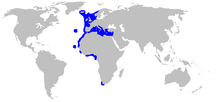| Velvet belly lanternshark | |
|---|---|

| |
| Scientific classification | |
| Domain: | Eukaryota |
| Kingdom: | Animalia |
| Phylum: | Chordata |
| Class: | Chondrichthyes |
| Subclass: | Elasmobranchii |
| Subdivision: | Selachimorpha |
| Order: | Squaliformes |
| Family: | Etmopteridae |
| Genus: | Etmopterus |
| Species: | E. spinax
|
| Binomial name | |
| Etmopterus spinax | |

| |
| Range of the velvet belly lantern shark | |
| Synonyms | |
* ambiguous synonym | |
The velvet belly lanternshark (or simply velvet belly) (Etmopterus spinax) is a species of dogfish shark in the family Etmopteridae. One of the most common deepwater sharks in the northeastern Atlantic Ocean, the velvet belly is found from Iceland and Norway to Gabon and South Africa at a depth of 20–2,490 m (66–8,169 ft).[2][3] A small shark generally no more than 45 cm (18 in) long, the velvet belly is so named because its black underside is abruptly distinct from the brown coloration on the rest of its body. The body of this species is fairly stout, with a moderately long snout and tail, and very small gill slits. Like other lanternsharks, the velvet belly is bioluminescent, with light-emitting photophores forming a species-specific pattern over its flanks and abdomen. The ventral photophores are thought to function in counter-illumination, which camouflages the shark against predators and prey.[4][5] The bioluminescent flank markings may play a role in intraspecific communication.[6]
Young velvet bellies feed mainly on krill and small bony fish, transitioning to squid and shrimp as they grow larger. There is evidence that individuals also move into deeper water as they age. This species exhibits a number of adaptations to living in the deep sea, such as specialized T-cells and liver proteins for dealing with the higher concentrations of heavy metals found there. Velvet bellies often carry a heavy parasite load. It is ovoviviparous, giving birth to litters of six to 20 young every two to three years. This species has virtually no commercial value, but large numbers are caught as bycatch in deepwater commercial fisheries. It has been assessed as Near Threatened by the International Union for Conservation of Nature, the heavy fishing pressure throughout its range and its slow reproductive rate are raising conservation concerns.
- ^ Finucci, B.; Derrick, D.; Dia, M.; Ducrocq, M.; Neat, F.C.; Pacoureau, N.; Serena, F.; VanderWright, W.J. (2021). "Etmopterus spinax". IUCN Red List of Threatened Species. 2021: e.T161388A124475610. doi:10.2305/IUCN.UK.2021-2.RLTS.T161388A124475610.en. Retrieved 19 November 2021.
- ^ 2015-12-15 - Velvet belly lanternshark/Etmopterus spinax and Rabbit fish/Chimaera monstrosa at 20 meters depth, retrieved 2015-12-25
- ^ Cite error: The named reference
jones et alwas invoked but never defined (see the help page). - ^ Straube, N.; Chenhong, L.; Claes, J.M.; Corrigan, S.; Naylor, G.J.P. (2015). "Molecular phylogeny of squaliforms and first occurrence of bioluminescence in sharks". Evolutionary Biology. 15: 162. doi:10.1186/s12862-015-0446-6. PMC 4537554. PMID 26277575.
- ^ Claes, J.M.; Aksnes, D.L.; Mallefet, J. (2010). "Phantom hunter of the fjords: Camouflage by counterillumination in a shark (Etmopterus spinax)". Journal of Experimental Marine Biology and Ecology. 388 (1–2): 28–32. doi:10.1016/j.jembe.2010.03.009.
- ^ Straube, N.; Iglésias, S.P.; Sellos, D.Y.; Kriwet, J.; Schliewen, U.K. (2010). "Molecular phylogeny and node time estimation of bioluminescent lantern sharks (Elasmobranchii: Etmopteridae)". Molecular Phylogenetics and Evolution. 56 (3): 905–917. doi:10.1016/j.ympev.2010.04.042. PMID 20457263.
